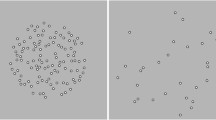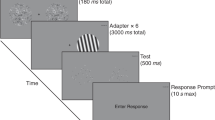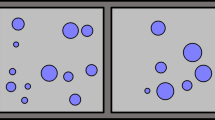Summary
This study deals with the observer's ability to discriminate the numerosity of two random dot-patterns irrespective of their relative size. One of these two patterns was a reference one that was always composed of 32 dots randomly distributed within aK ×K invisible square window (K = 1.92°). The second one was the test pattern with one of the five magnifications (K = 0.64°, 1.28°, 1.92°, 2.56°, 3.20°) and the relative number of dots varied on 11 levels (N = −15, −12, −9, −6, −3, 0, 3, 6, 9, 12, or 15 dots). The observer's task was to indicate which of the two patterns contained more dots. The results show that the stimulus size, as an irrelevant stimulus attribute, can be ignored in the judgements about relative numerosity. This means that the perceived numerosity is size invariant, at least for a 1.6-times magnification and a 3-times reduction of the test pattern. The size invariance observed constrains the range of potential models, since the perceived numerosity can be identified only by means of a feature of the stimulus that will remain invariant after any change in the absolute stimulus size.
Similar content being viewed by others
References
Allik, J., & Tuulmets, T. (1991 a). Occupancy model of perceived numerosity.Perception & Psychophysics, 49, 303–314.
Allik, J., & Tuulmets, T. (1991 b). The perception of visual numerosity. In R. Watt (Ed.),Vision and visual dysfunctions (Vol. 14). Pattern recognition by man and machine. Macmillan: London.
Atkinson, J., Campbell, F. W., & Francis, M. R. (1976). The magic number 4±0: A new look at visual numerosity judgements.Perception, 5, 327–334.
Besner, D. (1978). Pattern recognition: Are size and orientation additive factors?Perception & Psychophysics, 23, 93.
Besner, D. (1983). Visual pattern recognition: Size preprocessing reexamined.Quarterly Journal of Experimental Psychology, 35A, 209–216.
Bevan, W., Maier, R., & Helson, H. (1963). The influence of context upon the estimation of number.American Journal of Psychology, 76, 464–469.
Binet, A. (1890). La perception des longueurs et des nombres chez quelques petits enfants.Revue philosophique de la France et de l'étranger, 30, 68–81.
Bundesen, C., & Larsen, A. (1975). Visual transformation of size.Journal of Experimental Psychology: Human Perception and Performance, 1, 214–220.
Burt, P., & Sperling, G. (1981). Time, distance, and feature trade-offs in visual apparent motion.Psychological Review, 88, 171–195.
Diggle, P. J. (1983).Statistical analysis of spatial patterns. London: Academic Press.
Dixon, P. (1978). Numerical comparison processes.Memory & Cognition, 6, 454–461.
Foster, D. H. (1978). Visual comparison of random-dot patterns: Evidence concerning a fixed association between features and featurerelations.Quarterly Journal of Experimental Psychology,30, 637–654.
Frith, C. D., & Frith, U. (1972). The solitaire illusion: An illusion of numerosity.Perception & Psychophysics, 11, 409–410.
Ginsburg, N. (1976). Effect of item arrangement on perceived numerosity: Randomness vs regularity.Perceptual and Motor Skills, 43, 663–668.
Ginsburg, N. (1978). Perceived numerosity, item arrangement, and expectancy.American Journal of Psychology, 91, 267–273.
Ginsburg, N. (1980). The regular-random numerosity illusion: Rectangular patterns.Journal of General Psychology, 103, 211–216.
Ginsburg, N., & Goldstein, S. R. (1987). Measurement of visual cluster.American Journal of Psychology, 100, 193–203.
Helson, H., & Kozaki, A. (1968). Anchor effects using numerical estimates of simple dot patterns.Perception & Psychophysics, 4, 163–164.
Howe, E., & Jung, K. (1987). Judgement of numerosity: Effects of symmetry and goodness in dot pattern arrays.Acta Psychologica, 64, 3–11.
Jenkins, S. E., & Cole, B. L. (1982). The effect of the density of background elements on the conspicuity of objects.Vision Research, 22, 1241–1252.
Jevons, W. S. (1871). The power of numerical discrimination.Nature, 3, 281–282.
Julesz, B., & Schumer, R. A. (1981). Early visual perception.Annual Review of Psychology, 32, 575–627.
Krueger, L. E. (1972). Perceived numerosity.Perception & Psychophysics, 11, 5–9.
Krueger, L. E. (1984). Perceived numerosity: A comparison of magnitude production, magnitude estimation, and discrimination judgments.Perception & Psychophysics, 35, 536–542.
Larsen, A. (1985). Pattern matching: Effect of size ratio, angular difference in orientation, and familiarity.Perception & Psychophysics, 38, 63–68.
Larsen, A., & Bundesen, C. (1978). Size scaling in visual pattern recognition.Journal of Experimental Psychology: Human Perception and Performance, 4, 1–20.
Mart, D. (1982).Vision. New York: Freeman.
Newman, C. V. (1974). Detection of difference between visual textures with varying number of dots.Bulletin of the Psychonomic Society, 4, 201–202.
Petersik, J. T. (1989). The two-process distinction in apparent motion.Psychological Bulletin, 106, 107–127.
Pollack, I. (1972). Detection of changes in spatial position: 111. Dot number or dot density?Perception & Psychophysics, 12, 487–491.
Ponzo, M. (1928). Urteilstäuschungen über Mengen.Archiv für die gesamte Psychologie, 65, 129–162.
Ripley, B. D. (1981).Spatial statistics. New York: Wiley.
Santee, J. L., & Egeth, H. E. (1980). Selective attention in the speeded classification and comparison of multidimensional stimuli.Perception & Psychophysics, 28, 191–204.
Sekuler, R., & Nash, D. (1972). Speed of size scaling in human vision.Bulletin of Psychonomic Society, 27, 93–94.
Taves, E. H. (1941). Two mechanisms for the perception of visual numerousness.Archives of Psychology, 37, 1–47.
Tuulmets, T., & Allik, J. (1984). Spatiotemporal interpolation in the discrimination of visual number. In M. Rauk (Ed.),Computational models in hearing and vision (pp. 133–137). Tallinn: Academy of Sciences of the Estonian SSR.
Van Oeffelen, M. P., & Vos, P. G. (1982). Probabilistic model for the discrimination of visual number.Perception & Psychophysics, 32, 163–170.
Vos, P. G., Van Oeffelen, M. P., Tibosch, H. J., & Allik, J. (1988). Area-numerosity interactions.Psychological Research, 50, 148–150.
Watt, R. J. (1987). Scanning from coarse to fine spatial scales in the human visual system after the onset of a stimulus.Journal of the Optical Society of America, 4A, 2006–2021.
Watt, R. J. (1988).Visual processing: Computational, psychophysical, and cognitive research. Hove, UK: Erlbaum.
Watt, R. J., & Morgan, M. J. (1985). A theory of primitive spatial code in human vision.Vision Research, 25, 1661–1674.
Woodworth, R. S., & Schlosberg, H. (1954).Experimental psychology. New York: Holt.
Wundt, W. (1896).Grundriss der Psychologie. Leipzig: Engelmann.
Author information
Authors and Affiliations
Rights and permissions
About this article
Cite this article
Allik, J., Tuulmets, T. & Vos, P.G. Size invariance in visual number discrimination. Psychol. Res 53, 290–295 (1991). https://doi.org/10.1007/BF00920482
Received:
Accepted:
Issue Date:
DOI: https://doi.org/10.1007/BF00920482




